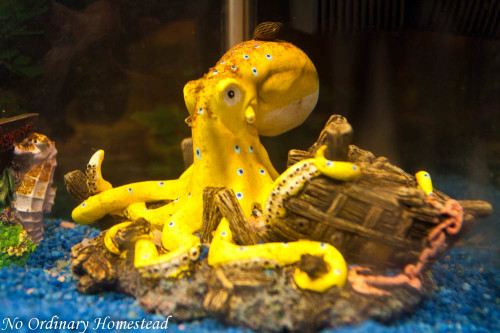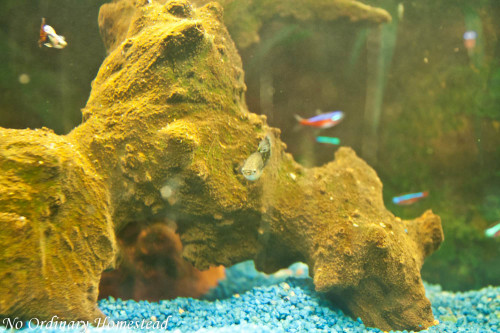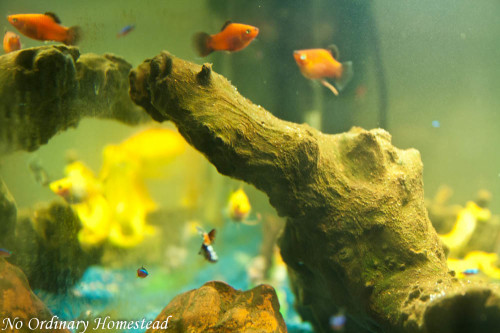Almost every child seems to go through a stage in their life where they want a fish for a pet. And parents want to indulge their children and give them a lesson in responsibility at the same time. But there is a lot more to allowing the child to take care of a fish than just buying them an aquarium, a fish and all other equipments. Taking care of a fish means responsibility, not only for the child but for the parents as well.
Back when we were still at the farm, Stefan managed to pick up a fish tank from a coworker for just a few bucks. It’s a fairly small tank, but we thought it would be great for Mackenzie since it included the stand, decorations and everything else you could need — aside from fish. I grew up with fish (among other cats and dogs) and Stefan has always been a fish fan — so it was a nice fit. Plus fish are rather simple to take care of, once you’ve got your tank balanced. Can a four-year-old take care of fish on her own? Definitely not! But with a little extra help on remembering to feed them each morning and evening, and someone cleaning the tank every week or two while she watches, we’ve been managing to make our fish quite happy.
When you allow your child to get a fish for a pet, you have to be realistic about it. Is he/she old enough to handle the responsibility? Does he/she understand what taking care of a pet entails? It’s very likely that you will need to take some responsibility as well. In fact, you may end being to be the one to take care of the fish and the tank as children’s enthusiasm may waver after a few weeks (it’s unfortunately already happened here). So always be prepared for that possibility. But thankfully mom and dad still find the fish cool. 😉

Things to remember when setting up a kid fish tank
- Parents are always worried when it comes to their children’s safety. If you are going to let your child own an aquarium and take care of a fish, the prospect of a tank being pulled over or bashed by toys (among other things) might be scaring you away from fish as a safe option. Ultimately, the thought of a tank breaking into pieces of glass is something to be concerned about. But in most cases, with a sturdy base under it, this won’t happen. When you pick out your tank, make sure that it is of good quality and made of approved glass. Glass tanks are often tempered which means they will shatter. If you’re not sure whether it is or not, look for the writing on the corner of the glass (like the one you find on your car windows. ) You may also want to consider acrylic tanks, which are used in public aquariums, and are usually lighter and stronger than glass.
- For younger children, you may want to find a lid that can accommodate a look. The lock prevents fish from being overfed as well as toys from taking a dip. More importantly, if your child has a break in the skin, you always have to be mindful that they don’t put their hands in the tank. If you have any chemicals meant for the aquarium, be store them in secure places out of reach of small hands.
- Tanks have all kinds equipment attached to them such as filters, lights, bubblers and other things. Any plugs, cables and sockets involved in setting up a tank should be protected and hidden. You don’t want things getting accidentally unplugged, caught in feet and pulling the tank over, or otherwise causing safety issues.
- Allow your child to decorate their fish tank. Kids do well with color for bright, visual impact. Include some interactive and educational pieces when you can. Mack picked out most of the stuff in our tank like our big yellow octopus and pink sea horse.
- As kids are mostly enthusiastic and excited, choose species of fish that don’t frighten easily. If you buy your fish in a reputable fish store, they should be able to give you some suggestions.
- The best size for a child’s tank is usually 10-20 gallon. It’s not too big making it easier to clean and it doesn’t take up much space. You can easily install a filter too. We usually just think of giving our kids a fish bowl and although it may appear cute and manageable, it can be difficult to clean because you can’t install a filter into it. Plus it’s really not comfortable for the fish in the long run. A tank smaller than 10 gallons can be very delicate and hard to keep balanced. Too little water can cause an imbalance that can be life threatening to a fish.
- Don’t get too many fish for your tank size. For a 10-gallon fish tank (usually 20″ long x 10” wide x 12″ tall), you can accommodate about 6 small goldfish (like Guppies or other Tetra), 10 mini-fish (like Neons) and a few snails — which happens to be our current setup.
- It is important to teach your kids that overfeeding is bad for the fish. It can pollute the tank and ultimately be the death of your tank.
- Unless you plan to do the majority of the work on the tank, start with a freshwater tank. It’s much easier to balance and maintain. Plus the fish are usually cheaper.
- Keep in mind that it will take a few weeks to get your fish tank balanced. So start with only a few fish (4 or 6 perhaps) and let them create the necessary bacteria first. Then you can add a few more fish later on. Don’t panic if the water gets really cloudy for a while. This is usually a sign that you’re on the right track. Investing in simple set of chemical fish tank testers is useful to make sure you’re making conditions better instead of worse.

What’s the best fish for a kids fish tank?
When we talk about finally giving in to our children’s enthusiasm for a fish tank, the first thing that comes probably to mind is a gold fish. It the most convenient choice, but it’s not the only kind of fish you can consider. Children are always drawn to any type of fish that’s cool and colorful but it may not be the right one for them to keep. Make sure you find out what size tank fish will need that you are interested in, because although the fish may be small when you buy them, they usually quickly double in size. And may grow to be much larger than you expect. The last thing you want is an overcrowded fish tank right from the start.
Aside from goldfish, Neons, Cardinals and other Tetras are good choices too. They come in bright colors and are quite active. They can keep your children occupied.
Barbs and Danios are hardy fish and can withstand the cooler water in case the heating goes off. White Cloud Mountain Minnow also tolerate cooler water temperatures and are active and entertaining fishes too.
On the other hand, you have the Guppies, Mollies, Platies and Swordtails, which are small, fairly affordable and easy to breed. What’s interesting about these mentioned fishes is that they are live-bearers, so if you manage to create a suitable breeding environment, you and your children will get to see the fry within a day or two of birth.
Are you a friend of fish tanks? Fresh or saltwater?



Trackbacks/Pingbacks